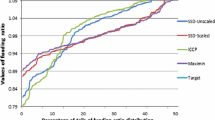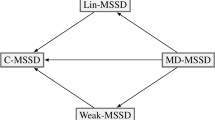Abstract
An Asset Liability Management model with a novel strategy for controlling the risk of underfunding is presented in this article. The basic model involves multi-period decisions (portfolio rebalancing) and deals with the usual uncertainty of investment returns and future liabilities. Therefore, it is well suited to a stochastic programming approach. A stochastic dominance concept is applied to control the risk of underfunding through modelling a chance constraint. A small numerical example and an out-of-sample backtest are provided to demonstrate the advantages of this new model, which includes stochastic dominance constraints, over the basic model and a passive investment strategy. Adding stochastic dominance constraints comes with a price. This complicates the structure of the underlying stochastic program. Indeed, the new constraints create a link between variables associated with different scenarios of the same time stage. This destroys the usual tree structure of the constraint matrix in the stochastic program and prevents the application of standard stochastic programming approaches, such as (nested) Benders decomposition and progressive hedging. Instead, we apply a structure-exploiting interior point method to this problem. The specialized interior point solver, object-oriented parallel solver, can deal efficiently with such problems and outperforms the industrial strength commercial solver CPLEX on our test problem set. Computational results on medium-scale problems with sizes reaching about one million variables demonstrate the efficiency of the specialized solution technique. The solution time for these non-trivial asset liability models appears to grow sublinearly with the key parameters of the model, such as the number of assets and the number of realizations of the benchmark portfolio, which makes the method applicable to truly large-scale problems.







Similar content being viewed by others
References
Birge, J.R. and Louveaux, F. (1997) Introduction to Stochastic Programming. New York: Springer-Verlag.
Blackwell, D. (1951) Comparison of experiments, in J. Neyman (ed) Second Berkeley Sympos. Math. Statist. and Probability. Berkeley, California: University of California Press, pp. 93–102.
Bogentoft, E., Romeijn, H.E. and Uryasev, S. (2001) Asset/liability management for pension funds using CVaR constraints. The Journal of Risk Finance 3 (1): 57–71.
Cariňo, D.R. et al (1994) The Russell–Yasuda Kasai model: An asset/liability model for a Japanese insurance company using multistage stochastic programming. Interfaces 24: 29–49.
Cariňo, D.R. and Ziemba, W.T. (1998) Formulation of the Russell–Yasuda Kasai financial model. Operations Research 46 (4): 433–449.
Consigli, G. and Dempster, M.A.H. (1998) Dynamic stochastic programming for asset-liability management. Annals of Operation Research 81: 131–161.
Dempster, M.A., Germano, M., Medova, E.A., Rietbergen, M.I., Sandrini, F. and Scrownston, M. (2007) Designing minimum guaranteed return funds. Quantitative Finance 7: 245–256.
Dentcheva, D., Henrion, R. and Ruszczyński, A. (2007) Stability and sensitivity of optimization problems with first order stochastic dominance constraints. SIAM Journal of Optimization 18 (1): 322–337.
Dentcheva, D. and Ruszczyński, A. (2003) Optimization with stochastic dominance constraints. SIAM Journal of Optimization 14 (2): 548–566.
Dentcheva, D. and Ruszczyński, A. (2004) Optimality and duality theory for stochastic optimization problems with nonlinear dominance constraints. Mathematical Programming 99: 329–350.
Dentcheva, D. and Ruszczyński, A. (2006) Portfolio optimization with stochastic dominance constraints. Journal of Banking Finance 30: 433–451.
Dentcheva, D. and Ruszczyński, A. (2009) Optimization with multivariate stochastic dominance constraints. Mathematical Programming 117: 111–127.
Fábián, C.I. and Veszpremi, A. (2008) Algorithms for handling CVaR constraints in dynamic stochastic programming models with applications to finance. Journal of Risk 10 (3): 111–131.
Fábián, C.I., Mitra, G. and Roman, D. (2009) Processing second-order stochastic dominance models using cutting-plane representations. Mathematical Programming 1–25, doi: 10.1007/s10107-009-0326-1.
Gollmer, R., Gotzes, U., Neise, F. and Schultz, R. (2007) Risk Modeling Via Stochastic Dominance in Power Systems With Dispersed Generation. Department of Mathematics, University of Duisburg-Essen. Technical report.
Gollmer, R., Gotzes, U. and Schultz, R. (2009) A note on second-order stochastic dominance constraints induced by mixed-integer linear recourse. Mathematical Programming, published online February 2009, 1–12.
Gollmer, R., Neise, F. and Schultz, R. (2008) Stochastic programs with first-order dominance constraints induced by mixed-integer linear recourse. SIAM Journal on Optimization 19: 552–571.
Gondzio, J. and Grothey, A. (2007a) Parallel interior point solver for structured quadratic programs: Application to financial planning problems. Annals of OR 152 (1): 319–339.
Gondzio, J. and Grothey, A. (2007b) Solving nonlinear portfolio optimization problems with the primal-dual interior point method. European Journal of Operational Research 181 (3): 1019–1029.
Gondzio, J. and Grothey, A. (2009) Exploiting structure in parallel implementation of interior point methods for optimization. Computational Management Science 6: 135–160.
Hadar, J. and Russell, W.R. (1969) Rules for ordering uncertain prospects. American Economic Review 59: 25–34.
Hanoch, G. and Levy, H. (1969) The efficiency analysis of choices involving risk. Review of Economics Studies 36: 335–346.
ILOG. Ilog cplex 10.0. http://www.ilog.com.
Kall, P. and Wallace, S.W. (1994) Stochastic Programming. Chichester: John Wiley & Sons.
Krokhmal, P., Palmquist, J. and Uryasev, S. (2001) Portfolio optimization with conditional value-at-risk objective and constraints. Journal of Risk 4 (2): 43–68.
Kusy, M.I. and Ziemba, W.T. (1986) A bank asset and liability management model. Operations Research 34 (3): 356–376.
Levy, H. (1992) Stochastic dominance and expected utility: Survey and analysis. Management Science 38 (4): 555–593.
Markowitz, H.M. (1959) Portfolio Selection, Efficient Diversification of Investments. New York: John Wiley& Sons.
Noyan, N., Rudolf, G. and Ruszczyński, A. (2006) Relaxations of linear programming problems with first order stochastic dominance constraints. Operations Research Letters 34: 653–659.
Ogryczak, W. and Ruszczyński, A. (2002) Dual stochastic dominance and related mean-risk models. SIAM Journal of Optimization 13 (1): 60–78.
Pyle, D.H. (1971) On the theory of financial intermediation. Journal of Finance 26: 737–747.
Rockafellar, R.T. and Wets, R.J.-B. (1991) Scenarios and policy aggregation in optimization under uncertainty. Mathematics of Operations Research 16 (1): 119–147.
Roman, D., Darby-Dowman, K. and Mitra, G. (2006) Portfolio construction based on stochastic dominance and target return distributions. Mathematical Programming 108: 541–569.
Ruszczyński, A. and Shapiro, A. (2006) Optimization of convex risk functions. Mathematics of Operation Research 31 (3): 433–452.
Ruszczyński, A. and Vanderbei, R.J. (2003) Frontiers of stochastic nondominated portfolios. Econometrica 71 (4): 1287–1297.
Ziemba, W.T. and Mulvey, J.M. (1998) Worldwide Asset and Liability Modeling, Publications of the Newton Institute Cambridge: Cambridge University Press.
Acknowledgements
We are grateful to Dr Marco Colombo for help with the efficient set up of the problem in OOPS. We are also grateful to two anonymous referees whose comments helped us to improve the presentation.
Author information
Authors and Affiliations
Additional information
1has recently been awarded a PhD in Optimization at the University of Edinburgh. She received her BSc in Computational Maths in China, and subsequently graduated with MSc in Financial Maths with distinction in Edinburgh, UK. Her main research interests are risk measures and management, stochastic dominance and stochastic programming.
Rights and permissions
About this article
Cite this article
Yang, X., Gondzio, J. & Grothey, A. Asset liability management modelling with risk control by stochastic dominance. J Asset Manag 11, 73–93 (2010). https://doi.org/10.1057/jam.2010.8
Received:
Revised:
Published:
Issue Date:
DOI: https://doi.org/10.1057/jam.2010.8




